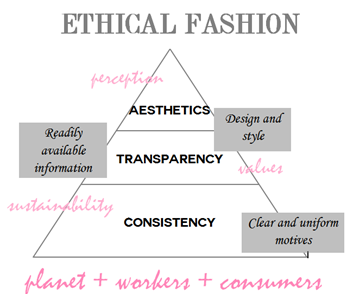FAS8-A1. Γνωρίζοντας την ηθική μόδα
TIMING/LENGTH (IN MINUTES): 30’
DESCRIPTION
In this activity you will learn about Ethical Fashion (what it is, why it is needed and some issues around it).
DEVELOPMENT/ METHODOLOGY
Make a mind map about Ethical Fashion.
Take 5 minutes to expand whatever you know about this term.
LEARN
Ethical fashion has no easy definition. However, there are various definitions of this term by blogs, experts, brands and consumers. One of the first papers debating “ethical fashion” was published in 2002 and little evidence of the expression is found before the beginning of the century. In general, it is a phrase only used in recent history even though some of its practices date far back.
Here are some definitions:
- Ethical Fashion is an umbrella term to describe ethical fashion design, production, retail, and purchasing. It covers a range of issues such as working conditions, exploitation, fair trade, sustainable production, the environment, and animal welfare. (Victoria and Albert Museum)
- ‘Ethical’ fashion refers to garments that have been produced in an environment that is conscious and engaged in the many social issues the fashion industry affects. (Study 34)
- Although there can’t be a unanimous definition of anything “ethical”, since such evaluation depends on a personal assessment of what constitutes a morally acceptable behaviour, many insist in attaching the word to anything related to human rights in the workplace and working conditions. Ethical fashion, thus, would be anything made under these standards. Similarly, people define sustainable fashion as a separate category where the methods and processes used are less polluting or help decrease the environmental impact of garment production. But a more holistic concept inside the slow fashion movement is that of ethical everything, from environmental considerations to labour rights and supply chain transparency. (Fashionedge)
Ethics pyramid by Fashionedge:

When ethics is discussed within the context of fashion, it most often refers to the treatment of people in the stages of raw material, processing and manufacture – activities typically carried out in the developing world.
Understood in a broader sense, it also refers to wages and working conditions in the retail sector, as well as to issues surrounding body image and the modelling industry. In the following image you can see a simplified version of the clothing supply chain:

Read more here:
- https://www.thegoodtrade.com/features/what-is-ethical-fashion
- http://www.vam.ac.uk/content/articles/w/what-is-ethical-fashion/
- https://www.study34.co.uk/pages/what-is-ethical-fashion
- https://fashionhedge.com/2014/12/29/ethical-sustainable-fashion-difference/
Which do you consider as the top 5 Ethical Issues in the Fashion Industry? Try to guess and note them down.
One of the issues around ethical fashion, has to do with the number of animals that are farmed in order to supply fur for the fashion industry. Many people feel that their welfare is an important part of the Ethical Fashion debate. Among them, there are also some designers. Stella McCartney for example does not use either fur or leather in her designs. In an advert for the animal rights organisation PETA, she said: “We address… ethical or ecological… questions in every other part of our lives except fashion. Mind-sets are changing, though, which is encouraging.”
Another issue has to do with the safety conditions of the workers. H&M for example, has been “a high street leader in using recycled and organic fabrics in its, equally ambiguously named, ‘conscious collection’ but has been widely criticised by the press and fair fashion campaigners, including Labour Behind The Label, as a token effort by a brand that promotes fast fashion and hasn’t kept up with promises to safeguard workers in their supply chain.“
Now read the following articles:
“Ethical Fashion 101: The Top 5 Ethical Issues in the Fashion Industry”
“The problem with the term Ethical Fashion”: https://www.forbes.com/sites/oliviapinnock/2018/05/29/the-problem-with-the-term-ethical-fashion/
Did you guess correctly?
DO
Now that you are aware about Ethical Fashion, go back to your mind map and update it. Compare and contrast it with the one you made at the beginning. (10minutes)